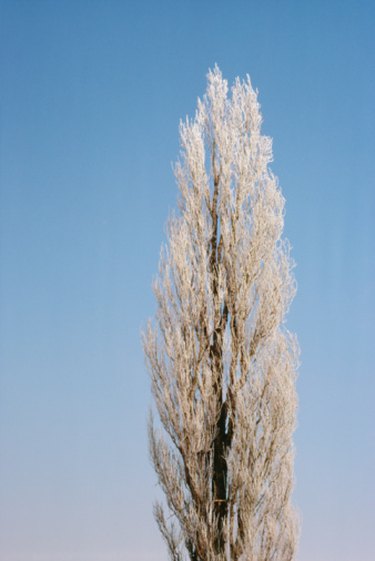
The white poplar or silver poplar (Populus alba) is susceptible to a number of diseases and pests capable of making the leaves of the tree fall prematurely in summer. Losing that foliage in midsummer places a burden on the poplar that forces it to recuperate and weakens it for the winter.
Marssonia Leaf Spot
Video of the Day
Marssonia leaf spot and blight (Marssonia) is a fungal disorder that more often attacks forest poplar that poplars in landscape settings. However, if an extensive period of wet weather occurs, it can also easily develop into a landscape problem. The fungus overwinters on infected dead leaves or branches, then spreads to new leaves in the spring as fungal spores are released into the air. The disease first afflicts lower branches then moves upward into the poplar.
Video of the Day
Marssonia Damage
Marssonia leaf spot and blight displays as brown spots on the leaves of the tree, with leaves turning completely brown in July and falling from the poplar in August. The tree may then produce a second generation of leaves, a process that saps it of strength and makes it more vulnerable to other diseases and winter injury. There is little that gardeners can do to prevent the spread of this disease aside from sterilization of garden tools.
Cytospora Canker
Cytospora canker of poplars is caused by the fungus Cytospora chrysosperma and is a devastating disease of the poplar species. It frequently kills Lombardy poplars (Populus nigra cv. 'Italica') within a span of 10 to 15 years. This fungal disease causes cankers, or sores, on the bark of the poplar that gradually grown larger and girdle the branch or twig, strangling the appendage and keeping it from receiving nutrition. As a result, twigs and branches die, with the leaves of the poplar also falling prematurely.
Leaf Rust
Several different leaf rust fungi of the genus Melampsora cause a poplar tree to lose its leaves in the summer. Wet weather exacerbates these diseases, with yellow spots forming on the upper leaf surface in spring. These spots then form into an orange, powdery substance that coats the leaves of the poplar, with the fungal spores spreading easily to adjacent trees. The leaf rust then becomes crusty and brown or black and leaves begin to wither and prematurely fall to the ground.